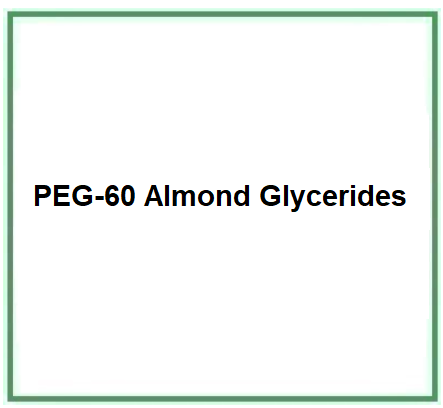PEG-60 Almond Glycerides is a chemical compound, alkyl glyceride, a mixture derived from PEG (PEG stands for Polyethylene glycol) from almond oil mono- and diglycerides. The number appearing after the abbreviation PEG refers to mol of ethylene oxide and the higher this number is, the less it can penetrate the skin.
The name describes the structure of the molecule:
- PEG-60 PEG stands for polyethylene glycol, which is a polymer of ethylene oxide. The number '60' indicates the average number of repeating units of ethylene oxide in the PEG chain.
- Almond Glycerides refers to glycerides derived from almond oil, molecules consisting of glycerol and fatty acids. Almond oil is rich in monounsaturated fatty acids and the glycerides derived from it contain these fatty acids.
The synthesis process takes place in different steps:
- Extraction. The first step involves extracting the oil from the almonds by cold pressing where the almonds are pressed to extract the oil.
- Glyceride formation. This is done through a process called hydrolysis in which the oil is broken down into its component fatty acids and glycerol. The fatty acids then recombine with the glycerol to form glycerides.
- PEGylation. Almond glycerides are modified to include polyethylene glycol (PEG) groups in a process in which PEG is attached to the almond glycerides using a catalyst. The number '60' in almond glycerides PEG-60 refers to the average number of ethylene glycol units in the PEG molecule.
PEG-60 Almond Glycerides is generally a light or pale yellow liquid, a little viscous at room temperature.

What it is used for and where
PEG-60 Almond Glycerides is a type of polyethylene glycol derived from almond oil. It is often used in cosmetics and personal care products as a skin conditioning agent, surfactant, and emulsifier.
Cosmetics
Skin conditioning agent - Emollient. Emollients have the characteristic of enhancing the skin barrier through a source of exogenous lipids that adhere to the skin, improving barrier properties by filling gaps in intercorneocyte clusters to improve hydration while protecting against inflammation. In practice, they have the ability to create a barrier that prevents transepidermal water loss. Emollients are described as degreasing or refreshing additives that improve the lipid content of the upper layers of the skin by preventing degreasing and drying of the skin. The problem with emollients is that many have a strong lipophilic character and are identified as occlusive ingredients; they are oily and fatty materials that remain on the skin surface and reduce transepidermal water loss. In cosmetics, emollients and moisturisers are often considered synonymous with humectants and occlusives.
Surfactant - Emulsifying agent. Emulsions are thermodynamically unstable. Emulsifiers have the property to reduce the oil/water or water/oil interfacial tension, improve emulsion stability and also directly influence the stability, sensory properties and surface tension of sunscreens by modulating their filmometric performance.
Since the PEG (Polyethylene glycol) family is very numerous and can be found in cosmetic, industrial, pharmaceutical, medical and other products, it is necessary to make an introductory statement on the subject, which is rather complex from a safety point of view because these products not only come into contact with the skin, but, as in the case of medical products, are ingested.
PEGs (polyethylene glycol) polymerise condensed ethylene oxide and water and are referred to as polyethylene glycols, but in reality they are complex chemical components, polymers bonded together. For example, plastic is polyethylene and has a hard consistency, while polyethylene combined with glycol forms a liquid. PEGylation is produced not only as etherification, but also as transesterification, which is the transformation of an alcohol by an ester. The number appearing after the abbreviation PEG refers to mol of ethylene oxide and the higher this number is, the less it can penetrate the skin.
Safety. The term 'eth' refers to the ethoxylation process (reaction with ethylene oxide) after which residues of ethylene oxide and 1,4-dioxane, chemical compounds considered carcinogenic, may remain in the final product. It depends on the degree of purity resulting from the completed reaction.
Safety
While PEG-60 Almond Glycerides is considered safe for use in cosmetics, some individuals may have an allergy or sensitivity to it, particularly if they have a nut allergy. Always patch test new skincare products before applying them to your entire face or body.
CAS: 124046-50-0 generic
![]() PEG-60 Almond Glycerides
PEG-60 Almond Glycerides 


